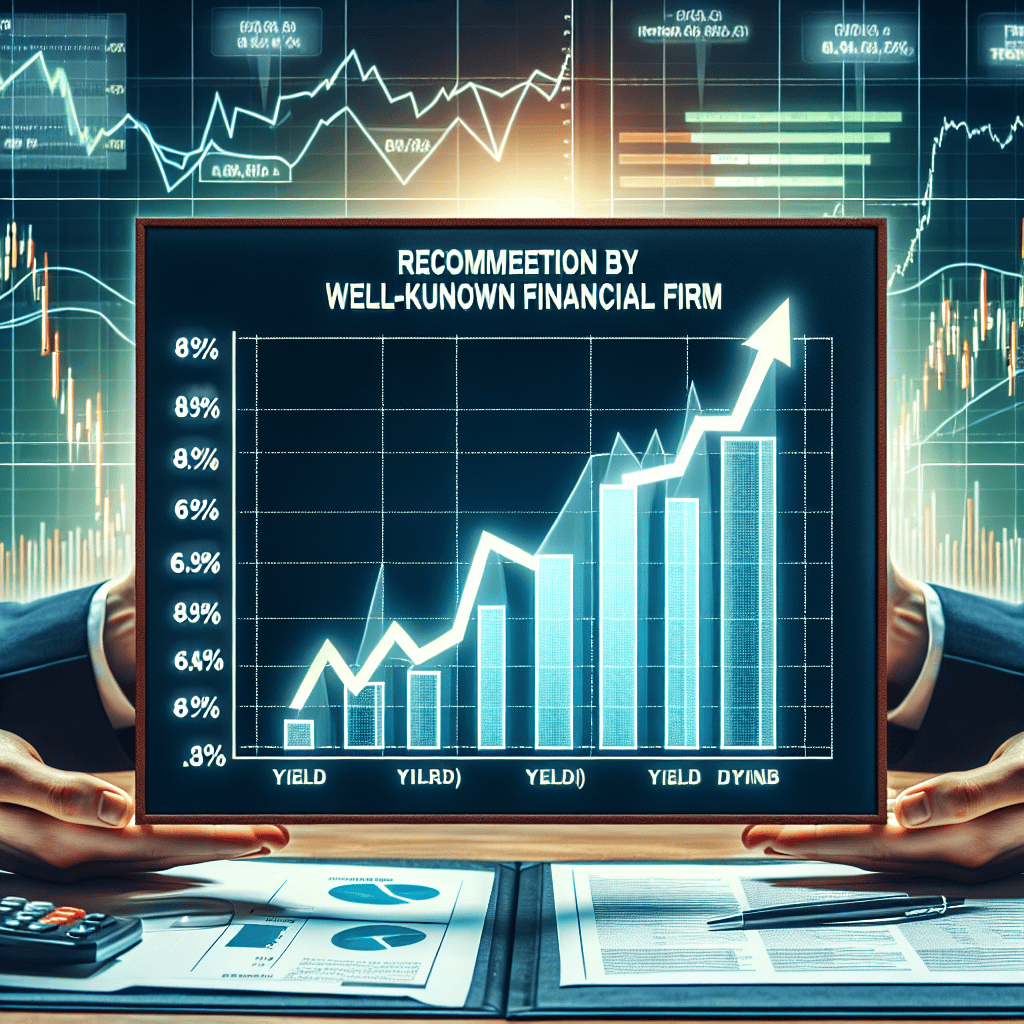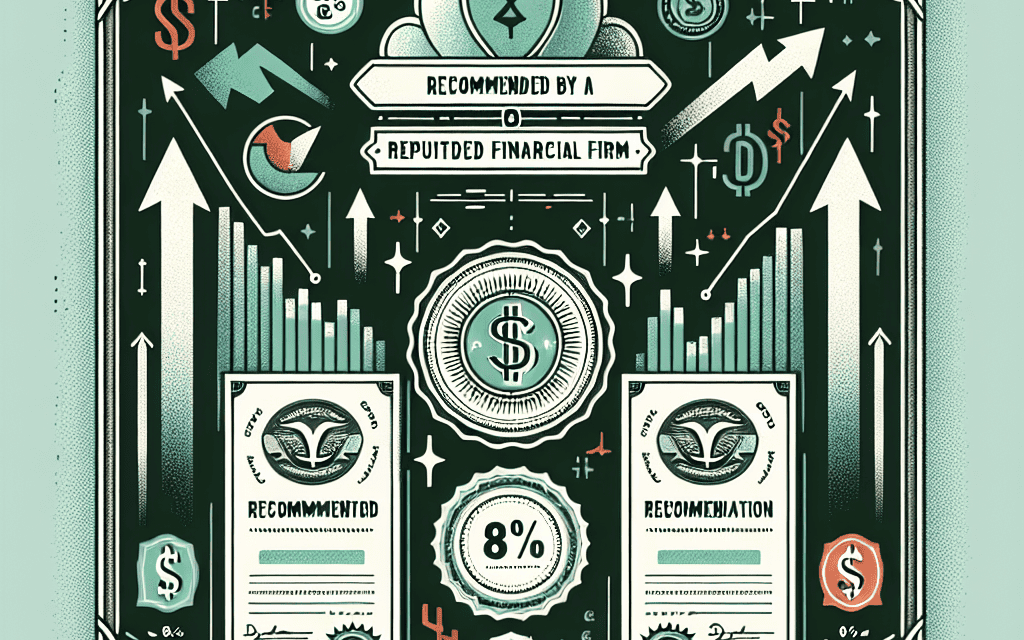“Maximize Your Returns: Raymond James Unveils Top Dividend Picks with 8%+ Yields”
Introduction
Raymond James, a renowned financial services firm, has recently spotlighted two dividend stocks that offer yields exceeding 8%, capturing the attention of income-focused investors. In an environment where market volatility and economic uncertainties persist, high-yield dividend stocks present an attractive opportunity for those seeking steady income streams. These recommendations by Raymond James not only highlight the potential for substantial dividend returns but also underscore the firm’s strategic approach to navigating the current financial landscape. By focusing on companies with robust dividend yields, Raymond James aims to provide investors with options that balance risk and reward, ensuring a consistent income flow while capitalizing on the potential for long-term growth.
Understanding Dividend Stocks: A Guide to High-Yield Investments
Investing in dividend stocks has long been a favored strategy for those seeking a steady income stream, particularly in times of market volatility. Dividend stocks are shares in companies that return a portion of their earnings to shareholders in the form of dividends. These payments can provide a reliable source of income, making them an attractive option for both conservative investors and those looking to supplement their income. Recently, Raymond James, a respected financial services firm, has highlighted two dividend stocks that offer yields exceeding 8%, drawing attention to the potential benefits of high-yield investments.
To understand the appeal of high-yield dividend stocks, it is essential to grasp the basic concept of dividend yield. The dividend yield is a financial ratio that shows how much a company pays out in dividends each year relative to its stock price. A higher yield can indicate a potentially lucrative investment, as it suggests a greater return on investment through dividends. However, it is crucial to consider the sustainability of these yields. Companies offering exceptionally high yields may be doing so because their stock prices have fallen, which could be a red flag indicating underlying financial issues.
Raymond James’ recommendation of two stocks with yields over 8% suggests that these companies have been evaluated for both their yield potential and their financial health. This dual focus is vital because a high yield is only beneficial if the company can maintain its dividend payments over time. Investors should look for companies with strong cash flows, manageable debt levels, and a history of consistent dividend payments. These factors can provide reassurance that the high yields are sustainable and not a result of temporary market fluctuations.
Moreover, investing in high-yield dividend stocks can offer several advantages beyond the immediate income. For one, dividends can provide a cushion against market downturns. When stock prices fall, the income from dividends can help offset losses, providing a measure of stability in an investor’s portfolio. Additionally, reinvesting dividends can lead to compounding returns over time, further enhancing the potential for wealth accumulation.
However, it is important to approach high-yield investments with a degree of caution. While the allure of substantial dividends is undeniable, investors must conduct thorough research to ensure that the companies in question are fundamentally sound. This involves analyzing financial statements, understanding the industry context, and keeping abreast of any news that might impact the company’s performance. Diversification is also key; relying too heavily on a single high-yield stock can expose investors to unnecessary risk.
In conclusion, Raymond James’ endorsement of two dividend stocks with yields exceeding 8% underscores the potential benefits of high-yield investments. These stocks can offer a compelling combination of income and growth, provided they are chosen with care and due diligence. By focusing on companies with strong financials and a track record of reliable dividend payments, investors can harness the power of dividends to enhance their portfolios. As with any investment strategy, a balanced approach that considers both the opportunities and risks will serve investors well in their pursuit of financial stability and growth.
Raymond James’ Top Picks: Exploring 8%+ Yield Dividend Stocks
In the ever-evolving landscape of investment opportunities, dividend stocks have consistently attracted investors seeking a reliable income stream. Among the myriad of financial institutions offering guidance, Raymond James stands out with its insightful recommendations. Recently, the firm has spotlighted two dividend stocks that boast yields exceeding 8%, capturing the attention of income-focused investors. These recommendations are not only a testament to the firm’s analytical prowess but also a reflection of the broader market trends favoring high-yield investments.
To begin with, dividend stocks are particularly appealing in times of economic uncertainty. They provide a dual benefit: potential capital appreciation and a steady income stream. This dual advantage becomes even more pronounced when the yields are as high as those recommended by Raymond James. The firm’s selection process involves a meticulous analysis of the companies’ financial health, market position, and future growth prospects. By focusing on stocks with yields over 8%, Raymond James is targeting investments that can offer substantial returns even in volatile market conditions.
The first stock recommended by Raymond James is a well-established player in the energy sector. This company has consistently demonstrated its ability to generate robust cash flows, which is crucial for maintaining and growing dividend payouts. The energy sector, despite its cyclical nature, remains a cornerstone of the global economy. With the ongoing transition towards sustainable energy sources, companies that can adapt and innovate are likely to thrive. Raymond James’ recommendation reflects confidence in this company’s strategic direction and its capacity to deliver shareholder value through dividends.
Transitioning to the second recommendation, Raymond James has identified a real estate investment trust (REIT) that offers an attractive yield. REITs are known for their high dividend payouts, as they are required by law to distribute a significant portion of their income to shareholders. This particular REIT has a diversified portfolio, encompassing various property types that provide a buffer against sector-specific downturns. The firm’s analysis suggests that the REIT’s management team has effectively navigated market challenges, positioning it for continued success. The high yield is indicative of the trust’s strong cash flow and prudent financial management.
Moreover, the appeal of these high-yield dividend stocks is further enhanced by the current low-interest-rate environment. With traditional fixed-income investments offering meager returns, investors are increasingly turning to dividend stocks as a viable alternative. The yields offered by the stocks recommended by Raymond James significantly outpace those of government bonds and savings accounts, making them an attractive option for income-seeking investors.
In conclusion, Raymond James’ recommendations of two dividend stocks with yields exceeding 8% underscore the firm’s commitment to identifying lucrative investment opportunities. These stocks not only promise substantial income but also offer potential for capital appreciation. As investors navigate the complexities of the financial markets, such expert guidance can be invaluable. By focusing on companies with strong fundamentals and strategic growth plans, Raymond James provides a pathway for investors to achieve their financial goals. As always, while these recommendations are compelling, investors should conduct their own due diligence and consider their individual risk tolerance before making investment decisions.
The Benefits of Investing in High-Yield Dividend Stocks
Investing in high-yield dividend stocks can be a strategic move for those seeking to enhance their income streams while potentially benefiting from capital appreciation. Raymond James, a renowned financial services firm, has recently recommended two dividend stocks that boast yields exceeding 8%, highlighting the potential advantages of such investments. Understanding the benefits of high-yield dividend stocks can help investors make informed decisions that align with their financial goals.
One of the primary benefits of investing in high-yield dividend stocks is the opportunity for consistent income generation. Unlike growth stocks, which may reinvest profits back into the company, dividend stocks distribute a portion of their earnings to shareholders in the form of dividends. This can provide a reliable income stream, particularly appealing to retirees or those seeking to supplement their income. With yields surpassing 8%, the stocks recommended by Raymond James offer an attractive option for investors looking to maximize their income potential.
Moreover, high-yield dividend stocks can serve as a hedge against market volatility. In times of economic uncertainty or market downturns, dividend-paying stocks often exhibit greater stability compared to non-dividend-paying counterparts. This is because companies that consistently pay dividends tend to have strong cash flows and solid financial foundations. As a result, they are better equipped to weather economic challenges, providing investors with a sense of security. The stocks highlighted by Raymond James not only offer high yields but also belong to companies with robust financial health, further enhancing their appeal.
In addition to income and stability, high-yield dividend stocks can contribute to long-term wealth accumulation. Reinvesting dividends through a dividend reinvestment plan (DRIP) allows investors to purchase additional shares, compounding their returns over time. This strategy can significantly enhance the overall value of an investment portfolio, particularly when dividends are reinvested during market dips, allowing investors to acquire more shares at lower prices. The compounding effect, combined with the high yields of the recommended stocks, can accelerate wealth growth, making them an attractive option for long-term investors.
Furthermore, high-yield dividend stocks can offer tax advantages, depending on the investor’s jurisdiction. In some regions, qualified dividends are taxed at a lower rate than ordinary income, providing a tax-efficient way to generate income. This can be particularly beneficial for investors in higher tax brackets, as it allows them to retain more of their earnings. Understanding the tax implications of dividend income is crucial for investors seeking to optimize their after-tax returns.
While the benefits of high-yield dividend stocks are compelling, it is essential for investors to conduct thorough research and consider potential risks. High yields can sometimes indicate underlying financial issues within a company, such as unsustainable payout ratios or declining earnings. Therefore, investors should assess the financial health and dividend sustainability of the companies in question. Raymond James’s recommendations are based on comprehensive analysis, but individual investors should also perform their due diligence to ensure alignment with their risk tolerance and investment objectives.
In conclusion, high-yield dividend stocks present a range of benefits, from consistent income and market stability to long-term wealth accumulation and potential tax advantages. The stocks recommended by Raymond James, with yields exceeding 8%, exemplify the potential of such investments. However, as with any investment, careful consideration and research are paramount to making informed decisions that align with one’s financial goals.
Analyzing the Risks and Rewards of 8%+ Yield Stocks

Investing in high-yield dividend stocks can be an enticing strategy for those seeking to generate substantial income from their portfolios. Raymond James, a respected financial services firm, has recently recommended two dividend stocks that offer yields exceeding 8%. While the allure of such high returns is undeniable, it is crucial for investors to carefully analyze the associated risks and rewards before making any investment decisions.
To begin with, high-yield dividend stocks often attract investors due to their potential to provide a steady income stream, especially in a low-interest-rate environment. These stocks can serve as a hedge against inflation, offering returns that may outpace the rising cost of living. Moreover, companies that pay high dividends are typically well-established, with stable cash flows and a commitment to returning capital to shareholders. This can provide a sense of security and predictability, which is particularly appealing to income-focused investors.
However, it is important to recognize that high yields can sometimes be a red flag, indicating underlying issues within a company. For instance, a stock may offer an unusually high dividend yield because its share price has significantly declined, possibly due to financial distress or declining business prospects. In such cases, the sustainability of the dividend payments may be in question, posing a risk to investors who rely on these payouts for income. Therefore, conducting thorough due diligence is essential to ensure that the high yield is not a result of temporary or structural problems within the company.
Furthermore, the sector in which a high-yield stock operates can also influence its risk profile. For example, companies in industries such as energy, real estate, or telecommunications often offer higher yields due to the capital-intensive nature of their businesses. While these sectors can provide lucrative opportunities, they are also subject to specific risks, such as regulatory changes, commodity price fluctuations, or technological disruptions. Investors must weigh these sector-specific risks against the potential rewards to make informed decisions.
In addition to sector considerations, the broader economic environment can impact the performance of high-yield stocks. During periods of economic uncertainty or market volatility, companies with high debt levels or cyclical business models may face challenges in maintaining their dividend payouts. Conversely, in a stable economic climate, these companies might thrive, providing consistent returns to investors. Thus, understanding the macroeconomic context is vital when evaluating the potential risks and rewards of high-yield dividend stocks.
Moreover, diversification plays a crucial role in managing the risks associated with high-yield investments. By spreading investments across various sectors and geographies, investors can mitigate the impact of adverse developments in any single area. This approach not only reduces risk but also enhances the potential for stable returns over the long term.
In conclusion, while Raymond James’s recommendation of two dividend stocks with yields exceeding 8% may appear attractive, investors must carefully assess the associated risks and rewards. By considering factors such as company fundamentals, sector dynamics, economic conditions, and diversification strategies, investors can make informed decisions that align with their financial goals and risk tolerance. Ultimately, a balanced approach that combines high-yield opportunities with prudent risk management can lead to a successful investment strategy.
How Raymond James Selects High-Yield Dividend Stocks
Raymond James, a renowned financial services firm, has long been recognized for its strategic approach to investment recommendations, particularly in the realm of high-yield dividend stocks. The firm’s methodology in selecting dividend stocks with yields exceeding 8% is both meticulous and comprehensive, ensuring that investors are presented with opportunities that not only promise substantial returns but also maintain a level of financial stability. Understanding the intricacies of this selection process provides valuable insight into how Raymond James identifies stocks that align with their high-yield criteria.
To begin with, Raymond James employs a rigorous screening process that focuses on the financial health and sustainability of a company’s dividend payouts. This involves a thorough analysis of the company’s balance sheet, cash flow statements, and income statements. By examining these financial documents, analysts can assess whether a company has the capacity to maintain or even increase its dividend payouts over time. This step is crucial, as it helps to filter out companies that may offer high yields but lack the financial stability to sustain them in the long run.
In addition to financial health, Raymond James places significant emphasis on the company’s business model and market position. Companies that operate in stable and mature industries are often preferred, as they are less susceptible to market volatility and economic downturns. This stability is essential for ensuring consistent dividend payments. Furthermore, the firm evaluates the competitive landscape to determine whether a company has a strong market position that can support its dividend strategy. Companies with a competitive edge, such as unique products or services, strong brand recognition, or significant market share, are more likely to generate steady cash flows, which are vital for sustaining high dividend yields.
Moreover, Raymond James considers the management team’s track record and their commitment to returning value to shareholders. A management team that has consistently prioritized dividend payments and demonstrated prudent financial management is often viewed favorably. This aspect of the evaluation process underscores the importance of leadership in maintaining a company’s dividend policy, as well as its overall financial health.
Transitioning from the qualitative aspects, Raymond James also incorporates quantitative metrics into their selection process. Key financial ratios, such as the dividend payout ratio, debt-to-equity ratio, and return on equity, are analyzed to gauge a company’s financial performance and its ability to support high dividend yields. A low dividend payout ratio, for instance, indicates that a company retains a significant portion of its earnings, providing a buffer for future dividend payments. Similarly, a manageable debt-to-equity ratio suggests that a company is not overly leveraged, reducing the risk of financial distress that could jeopardize dividend payments.
Finally, Raymond James remains vigilant about macroeconomic factors that could impact dividend stocks. Interest rates, inflation, and economic growth are all considered, as these elements can influence a company’s profitability and, consequently, its ability to pay dividends. By staying attuned to these broader economic trends, Raymond James ensures that their recommendations are not only based on current financial metrics but also on future economic conditions.
In conclusion, Raymond James’ approach to selecting high-yield dividend stocks is a blend of thorough financial analysis, strategic evaluation of business models, and consideration of macroeconomic factors. This comprehensive methodology enables the firm to identify stocks that offer attractive yields while maintaining a focus on financial stability and long-term growth potential. Through this meticulous process, Raymond James continues to provide investors with valuable insights and opportunities in the high-yield dividend stock market.
Comparing Dividend Stocks: What Makes an 8%+ Yield Attractive?
In the ever-evolving landscape of investment opportunities, dividend stocks have consistently attracted investors seeking a reliable income stream. Among these, stocks offering yields of 8% or more stand out, capturing the attention of both seasoned and novice investors. Raymond James, a respected name in financial services, has recently recommended two such dividend stocks, highlighting their potential to deliver substantial returns. Understanding what makes an 8%+ yield attractive requires a closer examination of the factors that contribute to the allure of these investments.
To begin with, dividend yields are a critical metric for evaluating the attractiveness of a stock. A yield of 8% or higher is particularly appealing in today’s low-interest-rate environment, where traditional savings accounts and bonds offer minimal returns. This high yield can provide a significant income stream, which is especially beneficial for retirees or those seeking passive income. Moreover, these yields can act as a buffer against market volatility, offering a degree of stability in uncertain times. However, it is essential to consider the sustainability of such high yields, as they can sometimes signal underlying financial distress within a company.
Transitioning to the specifics, Raymond James’s endorsement of these two dividend stocks suggests a level of confidence in their ability to maintain or even grow their payouts. This confidence is often rooted in the company’s financial health, business model, and market position. Companies with strong cash flows, manageable debt levels, and a history of consistent earnings are more likely to sustain high dividend yields. Additionally, firms operating in sectors with stable demand, such as utilities or consumer staples, are often better positioned to offer attractive dividends.
Furthermore, the potential for capital appreciation adds another layer of attractiveness to high-yield dividend stocks. While the primary focus for dividend investors is income, the possibility of stock price appreciation can enhance total returns. Companies that can effectively reinvest profits to drive growth while maintaining dividend payouts offer a compelling investment proposition. This dual benefit of income and growth potential makes high-yield dividend stocks a versatile component of a diversified portfolio.
Nevertheless, it is crucial to approach high-yield dividend stocks with a discerning eye. Not all high yields are created equal, and investors must conduct thorough due diligence. Factors such as payout ratios, earnings stability, and industry trends should be carefully analyzed. A payout ratio that is too high may indicate that a company is overextending itself to maintain its dividend, which could lead to cuts in the future. Similarly, understanding the broader industry context can provide insights into the sustainability of a company’s dividend policy.
In conclusion, the recommendation of two dividend stocks with yields exceeding 8% by Raymond James underscores the potential benefits of such investments. These stocks offer an attractive income stream, the possibility of capital appreciation, and a degree of stability in volatile markets. However, investors must remain vigilant, ensuring that the high yields are supported by strong fundamentals and sustainable business practices. By doing so, they can harness the full potential of these investments, balancing the pursuit of income with the need for long-term financial security.
Strategies for Building a Portfolio with High-Yield Dividend Stocks
In the ever-evolving landscape of investment strategies, high-yield dividend stocks have consistently attracted investors seeking both income and growth. Raymond James, a renowned financial services firm, has recently spotlighted two dividend stocks that boast yields exceeding 8%, offering a compelling opportunity for those looking to enhance their portfolios. As investors navigate the complexities of the market, understanding the nuances of high-yield dividend stocks becomes crucial. These stocks not only provide a steady income stream but also have the potential for capital appreciation, making them an attractive option for a balanced investment strategy.
To begin with, high-yield dividend stocks are particularly appealing in a low-interest-rate environment, where traditional fixed-income investments may not offer sufficient returns. By incorporating such stocks into a portfolio, investors can potentially achieve higher income without significantly increasing their risk exposure. However, it is essential to conduct thorough research and due diligence, as high yields can sometimes be indicative of underlying financial instability within a company. Therefore, selecting stocks recommended by reputable firms like Raymond James can provide a level of assurance regarding their financial health and sustainability.
Transitioning to the specific recommendations, Raymond James has identified two stocks that stand out due to their robust dividend yields and solid business models. These companies have demonstrated resilience in their respective industries, maintaining strong cash flows and a commitment to returning value to shareholders. By focusing on companies with a track record of consistent dividend payments, investors can mitigate some of the risks associated with high-yield stocks. Moreover, these stocks often belong to sectors that are less susceptible to economic downturns, providing an additional layer of security.
Furthermore, incorporating high-yield dividend stocks into a diversified portfolio can enhance overall returns while reducing volatility. Diversification remains a cornerstone of effective portfolio management, and by spreading investments across various asset classes and sectors, investors can better withstand market fluctuations. High-yield dividend stocks can play a pivotal role in this strategy, offering both income and growth potential. Additionally, reinvesting dividends can compound returns over time, further amplifying the benefits of this investment approach.
In addition to diversification, it is important to consider the tax implications of dividend income. Depending on an investor’s tax bracket and the nature of the dividends, the tax treatment can vary significantly. Qualified dividends, for instance, are typically taxed at a lower rate than ordinary income, which can enhance the after-tax return on investment. Therefore, consulting with a tax advisor can help investors optimize their portfolios for tax efficiency, ensuring that they retain as much of their dividend income as possible.
In conclusion, Raymond James’s recommendation of two high-yield dividend stocks with yields exceeding 8% presents a valuable opportunity for investors seeking to build a robust portfolio. By carefully selecting stocks with strong fundamentals and a history of reliable dividend payments, investors can achieve a balance of income and growth. As with any investment strategy, due diligence and diversification are key to managing risk and maximizing returns. By integrating high-yield dividend stocks into a well-rounded portfolio, investors can enjoy the benefits of a steady income stream while positioning themselves for long-term financial success.
Q&A
1. **What is the first dividend stock recommended by Raymond James?**
– The first dividend stock recommended by Raymond James is often a high-yielding company in sectors like energy or real estate, but specific names can vary over time.
2. **What is the second dividend stock recommended by Raymond James?**
– Similar to the first, the second stock is typically another high-yield option, potentially in sectors like utilities or financials, but the exact stock can change based on market conditions.
3. **What is the yield percentage of these recommended stocks?**
– Both recommended stocks have dividend yields of over 8%.
4. **Why does Raymond James recommend these stocks?**
– Raymond James recommends these stocks due to their high dividend yields, potential for stable income, and possibly strong fundamentals or favorable market conditions.
5. **What sector do these stocks typically belong to?**
– These stocks often belong to sectors known for high dividends, such as energy, real estate investment trusts (REITs), or utilities.
6. **What is a key risk associated with high-yield dividend stocks?**
– A key risk is that high yields can sometimes indicate underlying financial instability or market volatility, which could lead to dividend cuts.
7. **How does Raymond James assess the sustainability of these dividends?**
– Raymond James likely assesses sustainability by analyzing the company’s financial health, cash flow, payout ratios, and market conditions.
Conclusion
Raymond James has identified two dividend stocks with yields exceeding 8%, suggesting these investments as potentially attractive options for income-focused investors. The recommendation implies confidence in the companies’ ability to maintain or grow their dividend payouts, which can be appealing in a low-interest-rate environment. However, high-yield stocks often come with increased risk, so investors should conduct thorough due diligence to assess the sustainability of these dividends and the overall financial health of the companies.





